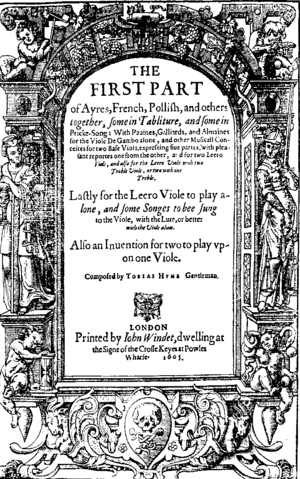Tobias Hume facts for kids

Tobias Hume (born around 1579, died 1645) was a talented Scottish composer, a skilled viol player, and a brave soldier. He lived a fascinating life during the 1600s.
Contents
Early Life and Military Career
Not much is known about Tobias Hume's early life. He might have been born in 1579. This idea comes from him joining the London Charterhouse in 1629. To join, people usually had to be at least 50 years old.
Hume worked as a professional soldier for many years. He served as an officer in the armies of Sweden and Russia. This shows he was a well-traveled and experienced person.
Musical Works and Instruments
Tobias Hume wrote many pieces of music. His works often featured the viol, an instrument similar to a cello. He especially liked the lyra viol, which was a type of viol played in a special way.
His music was collected in two main books:
- The First Part of Ayres (also called Musicall Humors), published in 1605.
- Captain Humes Poeticall Musicke, published in 1607.
Hume strongly believed the viol was better than the lute. The lute was a very popular instrument at the time. Another famous composer, John Dowland, even wrote against Hume's ideas.
Hume's Playful Side
Tobias Hume was known for being a bit of a prankster. Some of his musical pieces show his funny and unusual ideas.
Prince's Almayne
One of his most famous pieces is "An Invention for Two to Play upone one Viole." It is also known as "Prince's Almayne." This piece needs two viol players. The smaller player has to sit on the lap of the larger player! It also requires two bows. Even though it sounds funny, the music is actually possible to play. It was written using tablature, a special way to write music for string instruments.
Unique Playing Techniques
Hume also introduced new ways to play instruments. In his piece "Harke, harke," from First Part of Ayres, he tells players to "drum this with the backe of your bow." This is the earliest known use of col legno in Western music. Col legno means playing a string instrument by hitting the strings with the wooden part of the bow, not the hair.
Later Life
In 1629, around Christmas, Tobias Hume joined the Charterhouse. This was a home for poor gentlemen. He was still known as Captain Hume when he died there on April 16, 1645.
See also
 In Spanish: Tobias Hume para niños
In Spanish: Tobias Hume para niños

